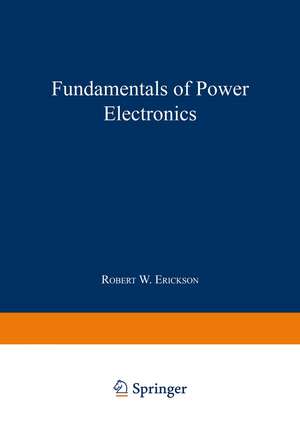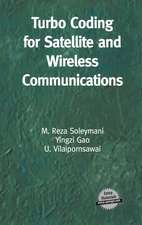Fundamentals of Power Electronics
Autor Ericksonen Limba Engleză Paperback – 7 mai 2013
Preț: 1140.23 lei
Preț vechi: 1390.53 lei
-18% Nou
Puncte Express: 1710
Preț estimativ în valută:
218.21€ • 236.94$ • 183.30£
218.21€ • 236.94$ • 183.30£
Carte tipărită la comandă
Livrare economică 22 aprilie-06 mai
Preluare comenzi: 021 569.72.76
Specificații
ISBN-13: 9781461576488
ISBN-10: 1461576482
Pagini: 792
Ilustrații: XVIII, 773 p. 13 illus.
Dimensiuni: 178 x 254 x 2 mm
Greutate: 1.35 kg
Ediția:Softcover reprint of the original 1st ed. 1997
Editura: Springer Us
Colecția Springer
Locul publicării:New York, NY, United States
ISBN-10: 1461576482
Pagini: 792
Ilustrații: XVIII, 773 p. 13 illus.
Dimensiuni: 178 x 254 x 2 mm
Greutate: 1.35 kg
Ediția:Softcover reprint of the original 1st ed. 1997
Editura: Springer Us
Colecția Springer
Locul publicării:New York, NY, United States
Public țintă
ResearchDescriere
In many university curricula, the power electronics field has evolved beyond the status of comprising one or two special-topics courses. Often there are several courses dealing with the power electronics field, covering the topics of converters, motor drives, and power devices, with possibly additional advanced courses in these areas as well. There may also be more traditional power-area courses in energy conversion, machines, and power systems. In the breadth vs. depth tradeoff, it no longer makes sense for one textbook to attempt to cover all of these courses; indeed, each course should ideally employ a dedicated textbook. This text is intended for use in introductory power electronics courses on converters, taught at the senior or first-year graduate level. There is sufficient material for a one year course or, at a faster pace with some material omitted, for two quarters or one semester. The first class on converters has been called a way of enticing control and electronics students into the power area via the "back door". The power electronics field is quite broad, and includes fundamentals in the areas of • Converter circuits and electronics • Control systems • Magnetics • Power applications • Design-oriented analysis This wide variety of areas is one of the things which makes the field so interesting and appealing to newcomers. This breadth also makes teaching the field a challenging undertaking, because one cannot assume that all students enrolled in the class have solid prerequisite knowledge in so many areas.
Cuprins
1. Introduction.- 2. Principles of Steady-State Converter Analysis.- 3. Steady-State Equivalent Circuit Modeling, Losses, and Efficiency.- 4. Switch Realization.- 5. The Discontinuous Conduction Mode.- 6. Converter Circuits.- 7. AC Equivalent Circuit Modeling.- 8. Converter Transfer Functions.- 9. Controller Design.- 10. Ac and dc Equivalent Circuit Modeling of the Discontinuous Conduction Mode.- 11. Current Programmed Control.- 12. Basic Magnetics Theory.- 13. Filter Inductor Design.- 14. Transformer Design.- 15. Power and Harmonics in Nonsinusoidal Systems.- 16. Line-Commutated Rectifiers.- 17. The Ideal Rectifier.- 18. Low Harmonic Rectifier Modeling and Control.- 19. Resonant Conversion.- 20. Quasi-Resonant Converters.- Appendices.- Appendix 1. RMS Values of Commonly-Observed Converter Waveforms.- A1.1. Some Common Waveforms.- A1.2. General Piecewise Waveform.- Appendix 2. Magnetics design tables.- A2.1. Pot core data.- A2.2. EE core data.- A2.3. EC core data.- A2.4. ETD core data.- A2.5. PQ core data.- A2.6. American wire gauge data.- References.























